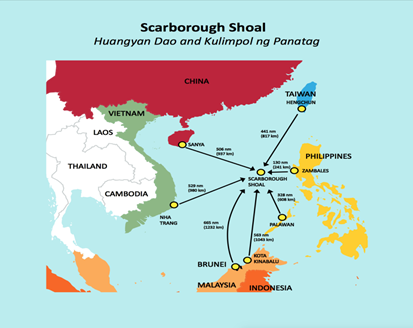

3rd October 2023 (9 Topics)
Context:
A recent dispute between China and the Philippines over the South China Sea turns the spotlight on tensions in the strategic waters with ramifications to all countries in the Indo-Pacific region, including India.
- The present dispute revolves around ‘Scarborough Shoal’ in the South China Sea.
|
Scarborough Shoal is located in the eastern part of the South China Sea.
|
About the dispute:
- This came days after Chinese Coast Guard ships placed a 300-metre-long barrier to prevent the entry of boats from the Philippines, the latest in long-running tensions in the South China Sea.
- The South China Sea dispute essentially revolves around multiple claims to the land features — islands and reefs — and associated territorial waters.
- Under the UN Convention on the Law of the Sea (UNCLOS), every state “has the right to establish the breadth of its territorial sea up to a limit not exceeding 12 nautical miles” and an Exclusive Economic Zone (EEZ) up to 200 nautical miles from the territorial sea baseline.
|
According to the Asia Maritime Transparency Initiative (AMTI), as many as 70 disputed reefs and islets are under contestation. The AMTI says China, Vietnam, the Philippines, Malaysia and Taiwan have built more than 90 outposts on these disputed features. |
South China Sea and ‘Code of Conduct’:
- Multiple countries, including China and ASEAN members, have disputes over the South China Sea. They've been trying to create a set of rules called a Code of Conduct (CoC) to manage these disputes.
- In 2002, ASEAN and China agreed on a Declaration of Conduct (DoC), which emphasized peaceful dispute resolution according to international law, including the United Nations Convention on the Law of the Sea (UNCLOS).
- In 2013, the Philippines initiated arbitration proceedings against China under UNCLOS, claiming China's actions violated the convention.
- In 2016, a tribunal ruled against China's "nine-dash line," which claimed nearly the entire South China Sea.
- The ruling found China's claims inconsistent with UNCLOS and clarified rules about exclusive economic zones and continental shelves around islands and rocks in the sea.
What are concerns of the region from China?
- China asserts extensive territorial claims in the South China Sea, encompassing almost the entire sea, often referred to as the "nine-dash line."
- These claims overlap with the claims of several other countries, including Taiwan, Vietnam, the Philippines, Malaysia, and Brunei.
- China has undertaken significant military and infrastructure development in the South China Sea, constructing artificial islands and fortifying them with military installations, runways, and missile systems.
- This has raised concerns among neighboring countries and the international community about China's expanding military presence in the region.
- China has been accused of challenging freedom of navigation in the South China Sea by asserting control over certain areas and waters.
- This has led to disputes and tensions with other countries and prompted freedom of navigation operations by the United States and other nations to assert their rights under international law.
- China's actions have sparked concerns about regional stability and the potential for conflict.
Concerns for India ‘as dispute continue’:
- The South China Sea holds the major Oil trade route for countries in the Pacific and India affects if the economy of these counties gets impacted.
- India’s interest in the region:
- India is seen as a vital player in the region, and Southeast Asian countries are keen to partner with India both economically and strategically.
- With India’s maritime discourse expanding and 55% of India’s trade passing through this region, India must pursue its interest in the region.
More Articles


